Mughal-Sikh Wars
The Mughal-Sikh Wars were a series of campaigns between Mughal and Sikh armies, taking place in present-day Pakistan and the India between the 16th and 18th centuries.
| Mughal-Sikh Wars | |||||||
|---|---|---|---|---|---|---|---|
| |||||||
| Belligerents | |||||||
| Sikhs | Mughal Empire | ||||||
Background
Between the 7th and 11th centuries, Islamic armies conducted several campaigns into the Hindu-dominated Indian subcontinent, making conquests limited to present-day Pakistan and the Punjab. From the 12th through the 16th century, however, Muslim conquests in the Indian subcontinent were more successful and saw the emergence of Islamic states over Hindu or Jain majority populations. In the early 16th century, one such state was the Mughal Empire, founded by the successful king Babur in northern India. Meanwhile, in the later 15th century in the Punjab, Sikhism had been proclaimed by Guru Nanak as a panentheistic sect, rejecting Hinduism and Islam, and rapidly gained followers. Perceiving the growth of the Sikhs as a threat, the Mughal authorities began to persecute them, and in 1606 Sikh leader Guru Arjan was executed by Mughal emperor Jahangir, apparently for helping prince Khusrau.[1] Sikhism split into two movements: one led by Guru Arjan's son Guru Hargobind began to regard Guru Arjan as a martyr, and sought justice through military and armed struggles, and started organising armed rebellions against the Mughals; the other led by Guru Arjan's older brother Prithi Chand focused on peace and nonviolence, and rejected uprisings.[1] Although Prithi Chand was paid by the Mughals such as Ram Rai to separate Sikhs.
Wars
The tenth and the last guru of Sikhs Guru Gobind Singh organised themselves in jathas, who would see their first battle in 1621. After several decades, small Sikh states known as misls combined to form the Sikh Confederacy in 1716, that jointly fought against Mughal power. In 1735, the jathas would be combined into a single army, the Dal Khalsa. Even though the Mughal Army had more military power, the Sikhs were overall successful in getting rid of the Mughals from the Punjab. The Sikh also severely weakened the Mughals during the first half of the 18th century. By the 1750s, the neighbouring northwestern Islamic Durrani Empire and the southern Hindu Maratha Empire had all but destroyed the weakened Mughal Empire, which retained a small territory around Delhi.
Battles fought by Sayyid Haider Khan
After Prithi Chand was a Sikh sect leader who wanted to separate the Sikh faith by dividing them. He was jealous of Guru Arjan as he was younger and still was elected Guru by Guru Ram Das ji. He planned to attack the Darbar Sahib and wanted to raid it. He held his own Darbar in a city near Lahore named Ha'ar but when he lead protests no one came except him. He allied with the Mughals and tried to convince Akbar to side with him but Akbar having a good perspective about Sikhism he did not agree. Although Sulib Khan Khan did and wanted to destroy it. Sayyed Hyder Khan ,a descendant of The Prophet, heard about this news and before they could attack the Darbar Sahib he was granted the Sikh army and fought against them. He won the battle and the Darbar Sahib was safe.
- Battle of Ha'ar
Battles fought by Guru HarGobind Sahib ji
After Guru Arjan Dev Ji's martyrdom he told his son, Guru HarGobind Sahib Ji that the Sikhs should know how to protect themselves. Guru HarGobind Sahib Ji made a leveled platform pointing 22 degrees West of the Darbar Sahib exactly at the Red Fort at Delhi to challenge Mughal authority, He called it the Akal Takht or timeless throne as a fort to protect the Darbar Sahib. Jehangir banned anyone except him and his governors and nobles to sit on leveled thrones so he attacked them and sent an army to Amritsar. Guru HarGobind Sahib Ji was prepared and defeated them in three battles.[2]
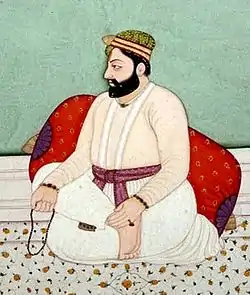
When Persians, an ally of the Mughals, were sending a hawk as a prize to Shah Jehan, Sikh hunting parties saw it and put it in a cage to be given to Guru Hargobind as a present. The Mughals responded with harsh language and the Sikhs refused to part with it. The Guru used it for hunting. Shah Jehan again attacked them with thousands of troops as it strained Mughal-Persian relations but the Sikhs came out victorious.
- Battle of Rohilla (1621)
- Battle of Amritsar (1634)
- Battle of Hargobindpur
- Battle of Gurusar
- Battle of Lahira.
- Battle for Maham.[3]
- Battle of Padiala
- Battle of Kiratpur
Battles Fought by Bhai Jattu
- Battle of Balachaur
Battles Fought by Baba Gurditta Ji
- Battle of Nakodar
Battles fought by Guru Har Rai ji
After Guru HarGobind Sahib Ji, Guru Har Rai ji was peaceful and tried his best not to engage in warfare but he still boosted Sikh army. He lived at Kiratpur, the largest herbal treatment centre and zoological garden in the Mughal Empire. He cured Dara Shikoh of smallpox when he was very young and sided with him during the Mughal War of succession against Aurangzeb. Aurangzeb tried to invade Kiratpur Sahib three times but failed all of them.
Battles fought by Guru Tegh Bahadur ji
Guru Tegh Bahadur Ji fought one battle under Guru HarGobind Sahib Ji against Painde Khan and Guru Tegh Bahadur Ji got his name from there. 'Tegh' is a broad bladed, heavy sword and Bahadur is a title meaning 'the brave'.
Battles fought by Shah-e-Shenshah Guru Gobind Singh Ji
Guru Gobind Singh ji was a young boy when he fought his first skirmish with the Hindu Hill rajas at 9 years old. The hill rajas were cruel to Buddhists and forced all of the people to pay unfair taxes as tribute to Mughals. The young Guru stayed at Paonta Sahib for most of his life writing literary works such as Tav Prasad Saviye, Choubis Avatar, Shabad Hazare, Fatehnama etc. One day Bhim Chand of Bilaspur and Fateh Shah of Garhwal were jealous of Guru Gobind Singh's riches and his well-prepared army so they allied. Despite them asking him to pay heavy taxes the Guru gave him them ten lakh Mughal Rupees for Bhim Chand's daughter's marriage. Later Guru Gobind Singh refused to pay unfair taxes and stopped. They later fought ten battles and a few skirmishes and later allied to completely stop the taxation of the people and the taxation of the rajas. The allied team fought against the Mughals and later the Hill rajas went back into being a vassal state of the Mughals.
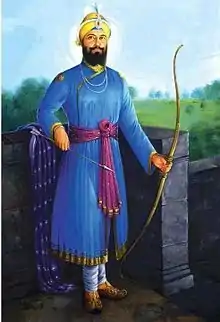
According to Sikh scriptures, Guru Gobind Singh came out with a sword at Anandpur Sahib and asked for five people who would give their head for Sikhism. One man entered and the Guru came out with a bloody sword. He asked for another head and again came out with a bloody sword. three times later he asked whether anyone else wanted and five people came. Then, a few minutes later, the Panj Pyare came out of the tent with navy blue and yellow clothes with kirpans in their hands and the Panj Mukte behind them with Nishan Sahibs. 30,000 people were baptized and took Khande di Pahul. He told them to always keep the Panj Kakkar or:
- Kesh: uncut hair
- Kangha: a comb
- Kara: an iron or steel bracelet worn on the wrist
- Kirpan: a sword or dagger to fight for justice and equality
- Kacchera: short breeches
He also announced a code of discipline for Khalsa warriors. Tobacco, eating meat slaughtered according to rituals and sexual intercourse with any person other than spouse were forbidden. The Khalsa also agreed to never interact with those who followed rivals or their successors. The co-initiation of men and women from different castes into the ranks of Khalsa also institutionalized the principle of equality in Sikhism regardless of one's caste or gender. According to Owen and Sambhi, Guru Gobind Singh's significance to the Sikh tradition has been very important, as he institutionalized the Khalsa, resisted the ongoing persecution by the Mughal Empire, and continued "the defence of Sikhism and the persecution against the Muslim assault of Aurangzeb". He told the Sikhs to fight against persecution no matter who the oppressor.

The four prohibitions or mandatory restrictions of the Khalsa or life of Khalsa at time of Gobind are:
- Not to disturb the natural growth of one's hair.
- Not to eat the kutha meat of any animal.
- Not to cohabit with a person other than one's spouse.
- Not to use tobacco, alcohol or any type of drugs.
Guru Gobind Singh ji continued and fought against the Mughals and won almost all of his battles. The most important battle that he fought was the Battle of Chamkaur, the fort of Chamkaur was surrounded and the only way through was to fight or surrender. The exact number of Mughals troops is not known but it varied from 4 lakh-5 lakh later with the reinforcements of the mughal troops they became 10 lakh (according to the zafarnama of Guru gobind singh ji to Aurangzeb and only 42 Sikhs were inside the fort, during first 3 clashes, where mughals charged directly towards the fort, the sikhs which were inside gave them tremendous and jaw-dropping damage where they killed several lakhs in 1 go, sikhs were so fierce during first three clashes that several commanders of the mughal army were wiped out without any single casualties to the sikhs Later Wazir Khan was so shocked that he commanded his army to maintain a barrier at the safe distance where sikhs artillary wont reach them, around the fort, sikhs charged on them continuously with groups of five as ordered by Guru Gobind Singh ji. Later Guru Gobind Singh ji survived and so did two of the Panj Pyare, three of the Panj Mukte and the Chote Sahibzaade. The Chote Sahibzaade, although were in the safekeeping of a Hindu Brahmin named Gangu who sold them and their grandmother to the cruel Wazir Khan who was given the task to fight Guru Gobind Singh. The young boys at the age of 7 and 9 were given the option to convert to Islam and get thousands of riches or die by being suffocated alive within a brick wall. They chose to die. Guru Gobind Singh's struggle stopped after the battle of Khidrana and Muktsar once the Zuffurnama reached Aurangzeb. They organized a meeting at Aurangabad but Aurangzeb died while Guru Gobind Singh ji was travelling there. He allied with the next secular Mughal emperor Bahadur Shah Zafar and sent Bhai Dharam Singh, the first of the Panj Pyare, to fight in the Battle of Jajau. Guru Gobind Singh reached Nanded and was stabbed three times in the heart by a descendant of Pandei Khan. He took his sword and killed him afterwards. His journey was almost over so he said that the Sikh scripture, the Guru Granth Sahib was the final and last Guru.
- Conflict with Bhim Chand
- Battle of Bhangani[5][6]
- Khazada Rustan Khan's Campaign
- Battle of Khazada
- Battle of Guler (1696)
- Battle of Nadaun
- Battle of Nimoh
- Hussain Khan's Campaign
- Hussaini Morcha
- Prince Muzzam's campaign
- Battle of Basoli[7]
- Battle of Jarranwala
- Battle of Anandpur (1700)
- First Battle of Anandpur (1704)
- First Battle of Chamkaur Sahib
- Battle of Sirsa
- Second Battle of Anandpur
- Battle of Nirmohgarh (1702)
- Battle of Bramhakund Sahib
- Battle of Satluj
- Battle of Shahi Tibbi
- Battle of Sarsa
- Second Battle of Chamkaur (1704)[8][9][10][11]
- Battle of Muktsar
- Battle of Khidrana
Battles fought by Sahibzada Ajit Singh
3. Battle of Bajrur
Battles fought by Bibi Deep Kaur
- Battle of Garhshankar
Battles fought by Sahibzada Jujhar Singh
- Battle of Sahibzada Jujhar Singh
- Battle of Kalmot
Battles fought by Bhai Mahi Singh
- Campaign against General Madan Khan
Battles fought by Zorawar Singh Palit
Battles fought by Banda Singh Bahadur
Banda Singh Bahadur was a Hindu Rajput who started to preach Vaishnav Hinduism in earlier Nanded, Hyderabad. He heard that a great prophet, Guru Gobind Singh was arriving so he went there and talked to him. He was given the task to avenge Guru Gobind Singh's younger sons.While he was travelling it is written that he fought many battles and created an empire from Gurdaspur to Panipat. He went up to the North and attacked Wazir Khan. He did campaigns in Muslim districts of Uttar Pradesh and Hindi Hill states. Five of his notable commanders were:
Baj Singh Bahadur- Descendant of the third Guru, Guru Amar Das Ji
Ram Singh- Brother of Baj Singh
Binod Singh- Descendant of the second Sikh Guru, Guru Angad Dev Ji
Kahan Singh- Binod Singh's son
Fateh Singh Bahadur- Killed Wazir Khan of Sirhind
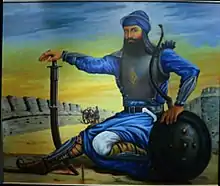
The most significant battle he fought was the battle of Chappar Chiri and the Battle of Gurdas Nangal. In the battle of Chappar Chiri a man named Tej Singh was fighting Wazir Khan when he cut of his arm, Fateh Singh seeing this charged at him and beheaded him. He threw Wazir Khan's head to a man on a war elephant and the mant attached the head to a spear and raised it. The Mughal army fled afterwards.
After the battle of Chappar Chiri, Banda Singh Bahadur declared Sikh sovereignty from Gurdaspur to Panipat. Ali Singh was made his deputy. Their chief responsibility was to be on guard against the Mughal troops from Lahore and Jammu. Fateh singh retained charge of Samana. Ram Singh, brother of Baj Singh became chief of Thanesar. Binod Singh in addition to his post of the revenue minister, was entrusted with the administration of Karnal and Panipat. His main duty was to guard the road from Delhi, the G.T. road. Banda retired to his capital at Lohgarh. His era began from May 12, 1710, the date of his victory in the battle of Sirhind. The Zamindari system and Jizya tax system was abolished in the whole province at one stroke.
- Battle of Sonepat[17] (1709).
- Battle of Bhoona
- Battle of Samana
- Battle of Ghurram
- Battle of Kapuri .
- Battle of Mukhlispur
- Battle of Chappar Chiri
- Battle of Kaithal
- Second Battle of Nahan
- Siege of Sirhind
- Seige of Fateh Burj
- Battle of Sadhaura[18][19][17][20]
- Battle of Banur
- Battle of Rahon (1710)
- Battle of Mustafabad
- Battle of Jalalabad (1710)
- Battle of Thanesar (1710)
- Seige of Lohgarh
- Battle of Jammu
- Siege of Gurdaspur or Battle of Gurdas Nangal
Battles fought by Fateh Singh Bahadur
- Battle of Mewat
- Looting of Malerkotla
- Battle of Muzzafarnagar
- Battle of Saharanpur
- Seige of Khurja
- Battle of Mat
- Battle of Chatta
Battles fought by Baj Singh Bahadur
- Battle of Indora
- Battle of Jaswan
- Battle of Harchakian
- Battle of Dera Gopipur
- Battle of Khundian
Battles fought by Binod Singh
- Battle of Taraori
- Battle of Amin
- Battle of Thanesar
- Battle of Shahabad
Battles fought by Ram Singh
- Battle of Mevati
- Battle of Arnin
Battles Fought by Nawab Kapur Singh
Kapur Singh soon gained a position of eminence among the Sikhs, who were then engaged in a desperate struggle against the Imperial Mughal government. Zakarya Khan, who had become the Mughal governor of Lahore in 1726, launched a policy of aggressive persecution against the Sikh masses of Punjab.
Kapur Singh headed a band of Sikh warriors who, with a view to paralysing the administration and obtaining food for their companions. They were forced to seek shelter in the lakhi ('The forest of a hundred thousand trees') jungles of Central Punjab. From here, they launched a series of sudden surprise attacks on government treasuries and caravans moving from one place to another. Due to the success of these campaigns, such was the effect of their depredations that the governor was soon obliged to make terms with them.
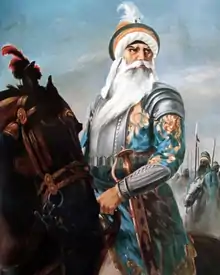
Nawab Kapur Singh led the Sikhs back to Majha to the Sarbat Khalsa at Amritsar. He was pursued by Lakhpat Rai's army near Amritsar and forced to turn away. The Taruna Dal promptly came to his help. The combined force fell upon Lakhpat Rai before he could reach Lahore and inflicted a severe defeat. His nephew, Duni Chand, and two important Faujdars, Jamal Khan and Tatar Khan, were killed in the battle.
- Campaign against Zakarya Khan Bahadur
- Campaign Against Jaspat Rai
- Campaign against Yahiya Khan
- Campaign against Mir Mannu
- Campaign against Mir Al Mulk
Battle fought by Bhai Bota Singh and Bhai Garja Singh
- Battle of Noordeen De Saraa
Battles fought by Bhai Sukha Singh and Bhai Mehtab Singh
- Battle of Mirankot
- Campaign against Nudin Faujdar
- Campaign against Shah Nawaz Khan
Battles fought by Bhai Tara Singh 'Wan'
- Battle of Wan
Battles fought By Bhai Aghar Singh
- Battle of Zain Khan
- Siege of Kasur
Battles fought by Jassa Singh Ahluwalia
Jassa Singh Ahluwalia was a pious Sikh man, raised by Mata Sundari the mother of the Khalsa, and was trained in the military by Nawab Kapur Singh. He proved to be one of the most capable and famous Sikhs for bringing the entire Punjab under the rule of Sikhs. Due to his influence the Khalsa is still surviving.
- Attack on Nadir Shah (1739)
- Killing Jaspat Rai
- Siege of Amritsar (1748)
- Sikh Occupation of Lahore
- Battle of Delhi (1783)
Battles fought by Jassa Singh Ramgarhia
Jassa Singh Ramgarhia was a prominent Sikh Misl leader in the 17th century. He fought against tyranny and persecution. He revived the concept of the Khalsa which did not hold any land and only fought for justice. Later he was under the pressure of his nobles and acquired land around the district of Hoshiarpur and Himachali areas.

- Siege of Ram Rauni
- Campaign against Mir Mannu
- Battle of Ramgarh fort
Battles fought by Bibi Baghel Kaur
- Battle of Dera Baba Nanak
Battles fought by Jodh Singh Ramgarhia
Jodh Singh Ramgharia , the son of Jassa Singh Ramgharia, was a great leader in a time when sikh leadership was absent. The Sikh Misls fought against each other and a sort of 'Cold War' broke out between the Bhangi, Nakkai, Dallelwala and the Sukherchakia, Ahluwalia, Karor Singhia. The Ramgharias joined the Bhangi Misl. The rest of the Misls (Shaheed, Singhpuria and Nishania) formed their own pact while the Phulkian Misl was excommunicated.
- Campaign against Qutubuddin
- Battle of Kasur
Battles fought by Rani Sada Kaur
Sada Kaur was an ambitious ruler of the Kaniyeha Misl. She campaigned against the joined Mughal-Afghan force in India and she fought the Mughals in numerous encounters. She got the Maharaja of Punjab, Ranjit Singh crowned king despite her doing most of the work in unifying the Misl states.
- Campaign against Zain Khan Sirhindi
- Battle of Khamanon
- Battle of Kharar
Battles fought by Baghel Singh
Karor Singhia was one of the strongest misls with 12,000 well- trained horsemen. The combined strength under Baghel Singh, including soldiers of a few sardars who joined him, was well over 20,000. He captured territories much beyond Delhi to include Meerut, Khurja, Aligarh,Tundla, Shikohabad, Farrukhabad, Agra and many other rich townships around Delhi, and collected tributes and rakhi from nawabs and rajas. He captured Saharanpur and overran the Rohilla territory in April 1775. In March 1776, Baghel Singh’s forces gave a crushing defeat to the Mughal army near Muzaffarnagar; thus Sikhs extended their influence on the whole of the Yamuna-Gangetic doab. After a alliance later on the Sikhs left Delhi and Awadh.
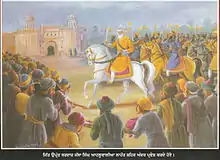
Battles fought by Bibi Shamsher Kaur
- Battle of Etmadpur
Battles fought by Bhai Ala Singh Patiala
Bhai Ala Singh was a ruler of Panipat and he never supported any Mughals or Afghans. He even fought Baba Ala Singh for supporting the Afghans in the third battle of Panipat. Baba Ala Singh provided food, water and resources for the Mahrattas. Later the Mahrattas sought to expand their empire so he fought them and repulsed their invasion with his wife and general Bibi Rajinder Kaur.
- Campaign against Muhamed Ali Khan Ruhila
- Campaign against Farid Khan
- Third battle of Panipat
Battles fought by Gulab Singh Dalevalia
- Campaign Against Ambo Khan of Kalanaur
- Attack on Pathan Traders
- Looting of Kasur
Battles fought by Fateh Singh Ahluwalia
Fateh Singh Ahluwalia was the last ruler of the independent Ahluwalia Misl later turned into the Kapurthala Princely State. He only ruled the district of Kapurthala and Jullundur. Maharaja Ranjit Singh took the other territories.
- Battle of Kasur
- Battle of Haidru
- Siege of Mankera
- Multan Campaign
- Hariana Campaign
Battles fought by Jathedar Akali Prahlad Singh Nihang
Akali Prahlad Singh became Jathedar of the Budha Dal after Hanuman Singh who fought the British on many occasions. To regain their trust and take revenge on the Mughals he suppressed the revolt of 1857 with fighting the collaborated force of Mahratta Nana Sahib and Bahadur Shah Zafar. The Mughals were cruel to minorities and he didn't want any other people to be forcibly converted to Islam.
Battles fought Against Mughals
Battles fought Against Mahratta Nana Sahib
Battles fought Against Jagdishpur Estate
See also
References
- Syan, Hardip Singh (2013). Sikh Militancy in the Seventeenth Century: Religious Violence in Mughal and Early Modern India. London & New York: I.B.Tauris. pp. 3, 252. ISBN 9781780762500. Retrieved 15 September 2019.
- Hasan, Prof M. (2002). HISTORY OF ISLAM (2 Vols. Set). Adam Publishers & Distributors. ISBN 978-81-7435-019-0.
- Dalbir Singh Dhillon (1988). Sikhism, Origin and Development. Atlantic Publishers. p. 119.
- Updates, Daily Sikh (2015-02-14). "The Battle Guru Tegh Bahadur Fought in 1635". DSU. Retrieved 2020-10-09.
- Bichitra Natak. Chapter 8, Chaupai 34 Archived 2011-07-17 at the Wayback Machine
- Raj Pal Singh (2004). The Sikhs : Their Journey Of Five Hundred Years. Pentagon Press. p. 35. ISBN 9788186505465.
- Surjit Singh Gandhi (2007). History of Sikh Gurus Retold: 1606–1708 C.E. Atlantic Publishers & Dist. p. 820. ISBN 9788126908585.
- Raju, Karam Singh. Guru Gobind Singh: Prophet of peace. ISBN 9380213646.
- Malhotra, Anshu; Mir, Farina (2012-02-21). Punjab Reconsidered: History, Culture, and Practice. ISBN 978-0-19-908877-5.
- Fenech, Louis E. (2013). The Sikh Zafar-namah of Guru Gobind Singh: A Discursive Blade in the Heart of the Mughal Empire. ISBN 978-0-19-993145-3.
- Surjit Singh Gandhi (2007). History of Sikh Gurus Retold: 1606–1708 C.E. Atlantic Publishers & Dist. p. 822. ISBN 9788126908585.
- kiratraj (2018-04-14). "The Panj Pyare". kirat raj singh. Retrieved 2020-10-16.
- "EPISODE-39 (PANJ PYARE-2 BHAI DHARAM SINGH & DR, DAULAT SNGH) – Avatar Meher Baba Prasar Kendra". Retrieved 2020-10-16.
- "Punj Piare ~ Bhai Dharam Singh | Anandpur Sahib | SinghSahib.com ~ a complete portal on Sikhism". www.singhsahib.com. Retrieved 2020-10-16.
- Tree, Speaking (2016-12-01). "Bhai Dharam Singh". Speaking Tree. Retrieved 2020-10-16.
- "Gurdwara Bhai Daya Singh Bhai Dharam Singh Nanded | Discover Sikhism". www.discoversikhism.com. Retrieved 2020-10-16.
- History of Islam, p. 506, at Google Books
- Sagoo, Harbans (2001). Banda Singh Bahadur and Sikh Sovereignty. Deep & Deep Publications.
- Raj Pal Singh (2004). The Sikhs : Their Journey Of Five Hundred Years. Pentagon Press. pp. 46–47. ISBN 9788186505465.
- Singha, H.S. (2005). Sikh Studies, Book 7. Hemkunt Press. p. 34. ISBN 9788170102458.
- Shaw, Jeffrey M.; Demy, Timothy J., eds. (2017). War and Religion: An Encyclopedia of Faith and Conflict. ABC-CLIO. pp. 574–577. ISBN 978-1-61069-517-6.
- Jacques, Tony (2007). Dictionary of Battles and Sieges: F-O. Greenwood Publishing Group. p. 421. ISBN 978-0-313-33536-5.